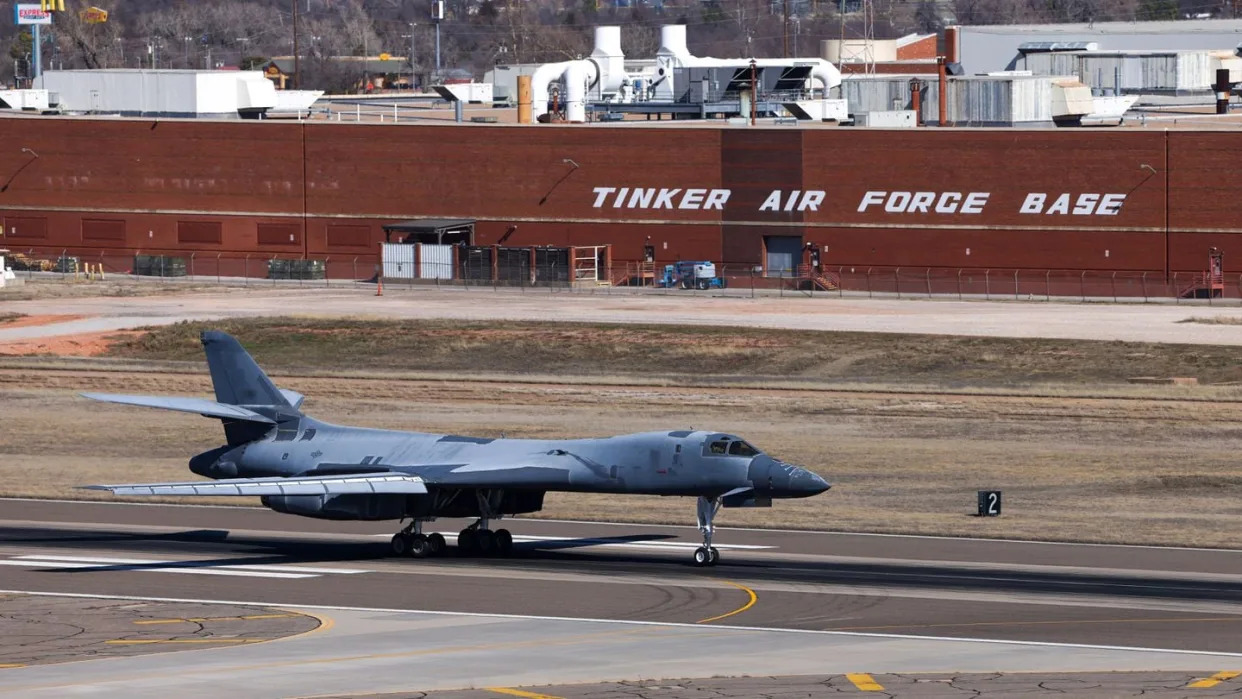B-1 bomber rises from the ‘Boneyard’ to rejoin the Air Force’s fleet

After a yearslong sabbatical in the desert, a retired B-1B Lancer will soon rejoin the Air Force’s bomber fleet.
The aircraft, nicknamed “Lancelot,” is slated to replace another B-1 bomber whose engine exploded during routine maintenance at Dyess Air Force Base, Texas, in April 2022. The accident caused more than $15 million in damages and sent an airman to a hospital with minor injuries, according to an Air Force investigation.
Cracked engine part sparked giant B-1 bomber fire, investigation finds
Read on AfriPrime Android Web View app ...Click on the link to Amazon Adroid app store....
The B-1 is a supersonic bomber capable of carrying conventional weapons; the first was delivered to the Air Force in 1985. The service has 45 Lancers in the fleet, down from its original inventory of 100.
The “Bone” fleet reached its current size in 2021 after the service retired 17 Lancers, including Lancelot, and is congressionally mandated to remain at its current size while the Air Force brings on the more advanced B-21 Raider.
Once the Air Force determined that repairing the torched bomber from the April 2022 mishap would cost too much, it turned to its “Boneyard” — otherwise known as the 309th Aircraft Maintenance and Regeneration Group at Davis-Monthan Air Force Base, Arizona — for a replacement. That’s where Lancelot landed after retiring from the 34th Bomb Squadron at Ellsworth AFB, South Dakota, on March 12, 2021.
The retired bomber was among four B-1s at the Boneyard in the highest level of preserved status, Joseph Stupic, senior materiel leader at the B-1 program office, told Air Force Times.
“This was the one that was probably the best for not requiring as much work,” Stupic said of Lancelot. “Some of them need structural updates and structural repairs. We looked at it and said, ‘Hey, the structure on this plane is pretty good. We can bring it into the fleet at a lower cost.’”
Preserving an aircraft and its parts is routine for the 309th AMARG, which does the initial work of draining an aircraft’s fluids and running a preservative oil through it, removing ejection seat rockets and sealing planes off from the elements. Resurrecting a retired bomber is much rarer.
The last time the Air Force called back defunct Lancers was in 2004, when the service revived seven of the aircraft after retiring 33 of them a year earlier, according to Air and Space Forces Magazine.
Teams from the 7th Bomb Wing at Dyess, as well those from the B-1 program office, the 76th Expeditionary Depot Maintenance Flight and the 569th Egress Flight at Tinker Air Force Base, Oklahoma, worked with the 309th AMARG to get Lancelot flight-ready.
Because the aircraft had sat dormant for a couple of years, multiple inspections, like safety checks of the aircraft’s wings and engine mounts, had to be completed. The 569th Egress Flight reassembled, tested and reinstalled ejection seats, hatches and other associated parts — totaling nearly 500 aircraft components — over three weeks, said James Jennings, a senior mechanic from the unit.
“It’s a lot of work,” Jennings said.
The amount of time that the aircraft had been unused, combined with the sand and wind of the Arizona desert, presented other challenges, said Master Sgt. Michael Wusstig, the 76th Aircraft Maintenance Group battle damage repair section chief. Fasteners holding down the aircraft’s panels were tougher to remove, but overall, Lancelot was in good shape.
“On this aircraft specifically, we didn’t find anything that raised any kind of red flags,” Wusstig said.
After being restored to flying condition, Lancelot landed at Tinker in early February, where it got other upgrades that it missed while in retirement, according to the 72nd Air Base Wing. That included catching up on a backlog of directives for one-time changes, modifications, inspections or installations of new equipment.
Lancelot is now beginning routine heavy maintenance at Tinker’s Oklahoma City Air Logistics Complex depot. That process is expected to take at least six months, but can go longer depending on what crews find after they strip down the aircraft. It is expected to begin its second life at Dyess later this year.
Reviving a bomber could be a once-in-a-lifetime experience for those who helped to return the aircraft to the skies.
It’s a full-circle moment for Wusstig, who saw the Lancer head to the Boneyard and its subsequent path back home.
“It was a lot more special … to see it at different levels,” he said.
- Questions and Answers
- Opinion
- Motivational and Inspiring Story
- Technology
- Live and Let live
- Focus
- Geopolitics
- Military-Arms/Equipment
- Ασφάλεια
- Economy/Economic
- Beasts of Nations
- Machine Tools-The “Mother Industry”
- Art
- Causes
- Crafts
- Dance
- Drinks
- Film/Movie
- Fitness
- Food
- Παιχνίδια
- Gardening
- Health
- Κεντρική Σελίδα
- Literature
- Music
- Networking
- άλλο
- Party
- Religion
- Shopping
- Sports
- Theater
- Health and Wellness
- News
- Culture


